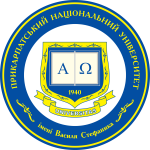Metal oxide magnetically controlled nanostructures for environmental and biomedical applications
State registration number: 0118U000254
Project duration: 1 January 2018 – 31 December 2020
Project executor: Vasyl Stefanyk Precarpathian National University (Project of the Ministry of Education and Science of Ukraine)
Project goals: to develop the scientific basis for the synthesis of non-agglomerated nanoparticles of magnetic ferrites with different cationic composition, to study the influence of non-magnetical active ions on their structural (particle size, cation distribution, etc.) and magnetic properties, as well as to obtain new materials that can be used in the environmental catalysis, water purification, magnetic hyperthermia and magnetic resonance imaging.
Specific project objectives are:
- To synthesize spinels with different cationic substitution in the crystal lattice and to investigate the effectiveness of various chemical methods (co-precipitation, sol-gel autocombustion method, microwave synthesis, microemulsion, template synthesis) for obtaining low agglomerated particles of spinel oxide nanomaterials.
- To investigate the influence of temperature and Me3+/Me2+ ratio on the structural and phase state of the obtained nanoparticles and their magnetic and optical properties.
- To investigate the catalytic and photocatalytic activity of spinel catalysts in soot combustion and N2O decomposition depending on the chemical and phase composition, synthesis method, annealing temperature, cation distribution and inversion
- To propose the ways of composition optimization for catalytic materials, and to show the influence of non-stoichiometry on the nature of crystal structure defects.
- To study the influence of synthesis conditions and surface modification on the adsorption properties and suitability for magnetic separation in the processes of water purification from heavy metals and organic pollutants.
- To reveal the correlation between structure, distribution of cations and the sorption properties of cationsubstituted spinels with different morphology and particle size synthesized according to the original methods.
Expected results:
- Development of theoretical, experimental and technological bases for obtaining new magnetocontrolled nanomaterials with predictable structure and properties.
- Implementation of the project objectives will allow to get new nanomaterials with controlled particle size distribution and improved catalytic, adsorption and magnetic properties.
- Synthesized nanomaterials will be tested as catalysts for soot combustion and decomposition of nitric oxide, as sorbents for water pollutants, as absorbers of electromagnetic radiation and as contrast agents for magnetic resonance imaging.
Contact person and project manager in Vasyl Stefanyk Precarpathian National University: Prof. Alexandr Shyichuk, Professor of the Department of Chemistry,
e-mail: oleksandr.shyichuk@pu.if.ua
